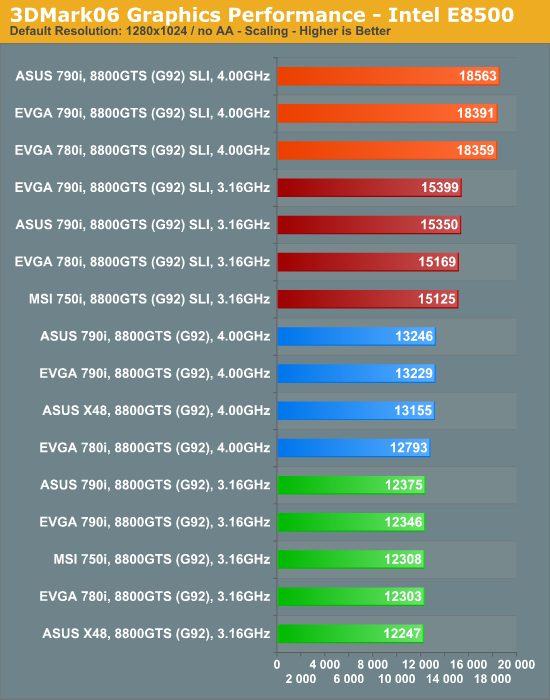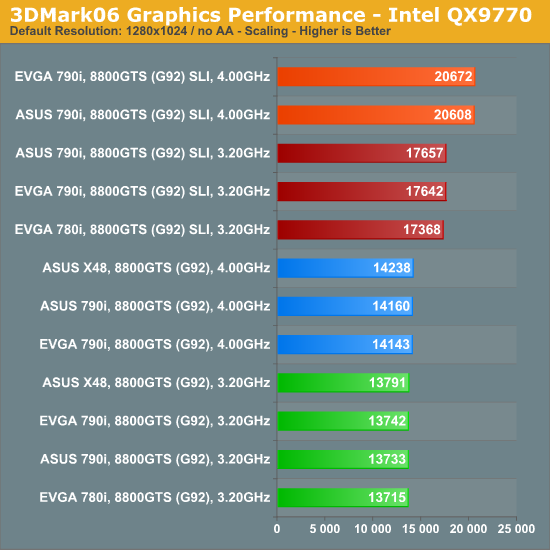ASUS Striker II Extreme: Mucho Bang, Mucho Bucks
by Kris Boughton on April 11, 2008 7:00 AM EST- Posted in
- Motherboards
Synthetic 3D Graphics Results
Futuremark's 3DMark06 benchmark scores depend solely on two subsystem evaluations: how powerful is your 3D graphics card(s) and just how good is your CPU at crunching numbers? In fact, memory bandwidth and access latencies have no noticeable effect on the final score. Of course, there are games that also show little benefit from improvements in the memory subsystem. Regardless, 3DMark06 is and always will be a synthetic benchmark and we put more stock in actual gaming performance results.
It is good for one thing though - it gives us a good idea of the gains made possible by installing a second, or even third or fourth GPU. However, this is not always the case as some games respond rather dismally to the addition of a second GPU while others may experience the nearly full theoretical performance increase (double the frame rate at an equivalent resolution).
What it really comes down to is how well the game has been engineered from the start to effectively distribute the graphics load across all available GPU resources. Yet another consideration in all of this is the level of success shared by the graphics drivers and platform solution in efficiently routing data between individual subsystems as needed to drive higher frame rates. Of course, the amount of CPU processing power available plays a role and as we will see, more capable processors sometimes allow SLI to offer additional scaling above what would be possible with a lesser CPU.

First out of the gate is our 45nm Intel E8500 dual-core CPU. Simply overclocking the processor to 4.00Ghz (8x500MHz), up from the default 3.16GHz frequency, produces only mild gains as measured by 3DMark06 - about 7% due entirely to the improved CPU test sub-score.
Adding a second GPU is an entirely different matter though - one in which graphics performance becomes linked with general processing power. Case in point: adding a second 8800GTS 512MB (G92) graphics card to our Striker II Extreme with the E8500 at default speeds result in about a 25% increase in 3DMarks (15,350 up from 12,375) while doing the same with the CPU overclocked to 4.00GHz shows over a 40% increase in 3DMarks (13,246 to 18,563).
Certainly, a portion of this gain can be attributed to the higher CPU speed, but the question then becomes, what percentage of the increase can be credited to improved SLI scaling? A quick calculation uncovers that had the scores at 4.00GHz with SLI not benefitted from the higher CPU sub-score it still would have beaten out the 15,350 3DMarks (E8500 at stock with SLI) by a healthy 12.2% with a score somewhere in the neighborhood of 17,222 3DMarks. Not only did a ~26.5% increase in CPU frequency result in a better CPU test sub-score but general graphics performance improved as well.

Our field of players for the quad-core tests is a little smaller due to a number of reasons - the first being our utter failure in getting the 45nm Intel QX9770 to boot Vista on the MSI PN7 SLI Platinum. (Seeing as this board uses the 750i chipset, this did not come as a surprise.) Secondly, our EVGA 780i board refused to play nice at the higher 4.00GHz clocks speed with a quad-core.
Both the EVGA reference 790i board and the ASUS Striker II Extreme easily eclipsed 20K 3DMarks on 3DMark06 with the QX9770 overclocked to a stable 4.00GHz and two 8800GTS 512MB (G92) cards in SLI. As we mentioned earlier, our graphics cards run at NVIDIA-specified stock clock speeds - even higher scores are possible using some vendors' "superclocked" models (or via user GPU overclocking). As we can see though, a 50% increase in 3DMarks can be achieved by simply installing a second graphics card and subsequently overclocking the QX9770 to 4.00GHz.










23 Comments
View All Comments
takumsawsherman - Saturday, April 12, 2008 - link
But for $400, you only get Firewire 400. Is that like a key, or something? If we pay $800 for a board, will they finally feel as though they can afford to add Firewire800, as Gigabyte did on their $200 boards like 3 or 4 years ago?When they talk about adding firewire itself to a board, does it never occur to them that a faster variation has existed for 5 or 6 years now? How insulting.
Grandpa - Saturday, April 12, 2008 - link
It doesn't matter what the price, performance, make, or model. If the board is unstable I don't want it! I had an Abit board once with a VIA chipset. It corrupted data when large files were transferred between drives. Several BIOS updates later, with the performance down to a crawl, it still corrupted data. Because of that ugly bad memory, stability is number one important for me. So this review is very relevant to others like myself.Super Nade - Friday, April 11, 2008 - link
As far as I know, the capacitors you mention are made by Fujitsu's Media division (FP-Cap series), not Fairchild semiconductor. Fujitsu did try to gobble up Fairchild in the 80's, but the US government killed the deal. Apart from this, I am not aware of any connection between these two companies.Here is the link--> http://jp.fujitsu.com/group/fmd/en/services/capaci...">http://jp.fujitsu.com/group/fmd/en/services/capaci...
S-N
Stele - Saturday, April 12, 2008 - link
Super Nade's right. The vendor marking on the capacitors - which have been the same for almost all such solid electrolytic polymer caps used on Asus boards for some time now - is very much that of Fujitsu: a letter 'F' in Courier-esque font between two horizontal lines.Interestingly - and confusingly - however, once upon a time this logo was indeed that of Fairchild Semiconductor... the deal that almost happened in the 80s may have something to do with Fujitsu's current use of the said logo. Either way, Faichild Semi have long since changed to their current logo (a stylised italic 'f') so today, any current/new electronic/semiconductor component carrying the F-between-bars logo is almost certainly a Fujitsu product.
jojo29 - Friday, April 11, 2008 - link
Just wondering how the Anandtech's Choice P5E3 Premium ( which i plan on buying) stacks up against this Striker? Any comments? Or did i miss something in the aricle as i was only able to skim through it, as im at work atm, and dontcoughwantcoughtogetcaughtbymybosscough...kjboughton - Friday, April 11, 2008 - link
We used one X48 motherboard in this review and it was the ASUS P5E3 Premium. Enjoy the full read when you make it home. ;)ImmortalZ - Friday, April 11, 2008 - link
You mention that overclocking the PCI-E bus provided tangible performance benefits on the EVGA board.Did you read about the rumblings around the net about some G92 based cards overclocking their GPU with the PCI-E bus? There are supposedly two clock sources for these type of cards - one on board and the other slaved to the PCI-E bus.
Are you sure that the performance improvement is not because of this anomaly?
CrystalBay - Friday, April 11, 2008 - link
Hi Kris, while UT3 does scale very well with multi-core. The game it self has no DX10 support as of yet. Hopefully EPIC will will enable it in a future update...Glenn - Friday, April 11, 2008 - link
All the benchies and comparisons are great, but how does it compare to a P35 board? A 965 or X38 board? I doubt you will convert those that already own an X48 and I (P35) have no point of reference within this article to see if I'm 5, 10 or 25% behind the preformance curve?Rolphus - Friday, April 11, 2008 - link
Interesting review... only one question though. Why use the 32-bit version of Crysis on Vista x64? Is there an issue with the 64-bit version that I don't know about?